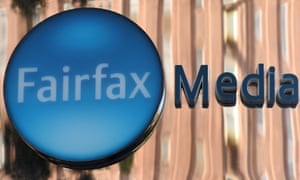Extract from The Guardian
Fairfax Media will continue to print its daily newspapers for several
years, its chief executive, Greg Hywood, confirmed at the company’s
results meeting. The publisher tripled its profits to $84m in the half-year to December 2016 compared to the same period last financial year.
“While we have considered many options, the model we have developed involves continuing to print our publications daily for some years yet,” Hywood said. “This is the best commercial outcome for shareholders based on current advertising and subscription trends.”
Last August Hywood said the Sydney Morning Herald and the Age’s seven-day printing model would “eventually give way to weekend-only” but that prediction is not to come true any day soon.
Last week the publisher radically restructured the way the papers were run, removing the role of editor-in-chief following the resignation of Sydney Morning Herald editor-in-chief Darren Goodsir.
The Age and the Herald now have local editors only and national, political and international coverage across both mastheads is handled by Fairfax Media national editor James Chessell.
Fairfax Media also announced that the profitable online real estate
business, Domain, may be spun off into a separate company to attract
shareholders who may not want to invest in the traditional newspaper
business.
In the six months to December 2016, Domain’s digital advertising grew by 15%, in contrast with the mastheads’ print advertising revenue which declined 16%.
“Fairfax would continue to own a controlling majority of Domain – between 60-70% – while issuing shares in Domain to Fairfax shareholders at the time the separation is implemented,” Hywood said.
“The separation of Domain would further reshape the Fairfax portfolio by adopting a more flexible corporate structure to maximise shareholder value.
A strategic review of the Domain Group would be conducted and approval sought from the Australian Tax Office and shareholders before a final decision was made to list Domain as an ASX-listed entity.
Despite a continued downturn in revenue, Fairfax reported its net profit after tax was up from $27m to $84m from the same period in 2015.
“Our three publishing businesses maintained an intense focus on cost reduction, a stronger emphasis on digital publishing, and made progress in building new revenue opportunities,” Hywood said.
“We are pleased with the continued profitability of our publishing businesses in the face of the largest structural change in the industry’s history. This is a remarkable performance, which few publishers globally have matched.”
Across the metropolitan mastheads, including the Australian Financial Review and the events business, revenue declined 8%.
Stan, the TV streaming service joint venture with Nine, continued to grow despite strong competition from Netlfix. Stan had more than 700,000 active subscribers.
“In October, CEO Mike Sneesby outlined his expectations for improving momentum in subscriber sign-ups based on an outstanding programming line-up,” Hywood said. “That performance has been exceeded and culminated in January delivering Stan’s biggest ever month in subscriber sign-ups.”
“While we have considered many options, the model we have developed involves continuing to print our publications daily for some years yet,” Hywood said. “This is the best commercial outcome for shareholders based on current advertising and subscription trends.”
Last August Hywood said the Sydney Morning Herald and the Age’s seven-day printing model would “eventually give way to weekend-only” but that prediction is not to come true any day soon.
Last week the publisher radically restructured the way the papers were run, removing the role of editor-in-chief following the resignation of Sydney Morning Herald editor-in-chief Darren Goodsir.
The Age and the Herald now have local editors only and national, political and international coverage across both mastheads is handled by Fairfax Media national editor James Chessell.
In the six months to December 2016, Domain’s digital advertising grew by 15%, in contrast with the mastheads’ print advertising revenue which declined 16%.
“Fairfax would continue to own a controlling majority of Domain – between 60-70% – while issuing shares in Domain to Fairfax shareholders at the time the separation is implemented,” Hywood said.
“The separation of Domain would further reshape the Fairfax portfolio by adopting a more flexible corporate structure to maximise shareholder value.
A strategic review of the Domain Group would be conducted and approval sought from the Australian Tax Office and shareholders before a final decision was made to list Domain as an ASX-listed entity.
Despite a continued downturn in revenue, Fairfax reported its net profit after tax was up from $27m to $84m from the same period in 2015.
“Our three publishing businesses maintained an intense focus on cost reduction, a stronger emphasis on digital publishing, and made progress in building new revenue opportunities,” Hywood said.
“We are pleased with the continued profitability of our publishing businesses in the face of the largest structural change in the industry’s history. This is a remarkable performance, which few publishers globally have matched.”
Across the metropolitan mastheads, including the Australian Financial Review and the events business, revenue declined 8%.
Stan, the TV streaming service joint venture with Nine, continued to grow despite strong competition from Netlfix. Stan had more than 700,000 active subscribers.
“In October, CEO Mike Sneesby outlined his expectations for improving momentum in subscriber sign-ups based on an outstanding programming line-up,” Hywood said. “That performance has been exceeded and culminated in January delivering Stan’s biggest ever month in subscriber sign-ups.”

No comments:
Post a Comment